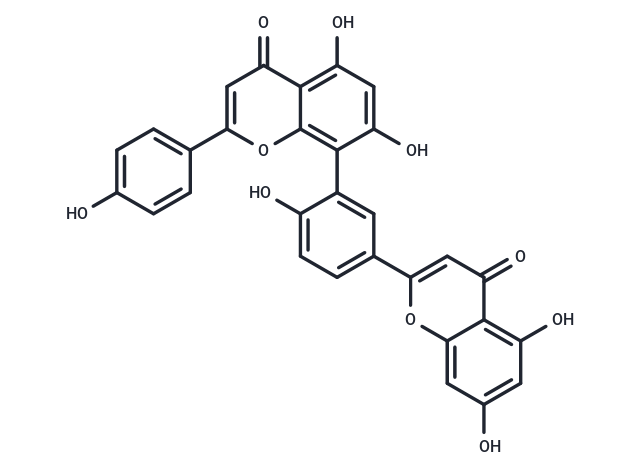 Your shopping cart is currently empty
Your shopping cart is currently empty

Amentoflavone (3',8''-Biapigenin), as a potent inhibitor of CYP3A4 and CYP2C9, can interact with many other medications. CYP3A4 and CYP2C9 are proteins used for drug metabolism in the body. Amentoflavone also is an inhibitor of human cathepsin B. It has antimalarial activity in trials significant affinities towards the Delta-1, kappa opioid receptors (as an antagonist) and binds to benzodiazepine receptors. Amentoflavone may be a potential lead for a new type of anti-inflammatory agents having the dual inhibitory activity of group II phospholipase A2 and cyclooxygenase. Amentoflavone and quercetin differentially exerted suppression of PGE2 biosynthesis via downregulation of COX-2/iNOS expression.

| Pack Size | Price | USA Warehouse | Global Warehouse | Quantity |
|---|---|---|---|---|
| 2 mg | $30 | In Stock | In Stock | |
| 5 mg | $48 | In Stock | In Stock | |
| 10 mg | $77 | In Stock | In Stock | |
| 25 mg | $135 | In Stock | In Stock | |
| 50 mg | $239 | In Stock | In Stock | |
| 100 mg | $388 | In Stock | In Stock | |
| 200 mg | $568 | In Stock | In Stock | |
| 1 mL x 10 mM (in DMSO) | $57 | In Stock | In Stock |
| Description | Amentoflavone (3',8''-Biapigenin), as a potent inhibitor of CYP3A4 and CYP2C9, can interact with many other medications. CYP3A4 and CYP2C9 are proteins used for drug metabolism in the body. Amentoflavone also is an inhibitor of human cathepsin B. It has antimalarial activity in trials significant affinities towards the Delta-1, kappa opioid receptors (as an antagonist) and binds to benzodiazepine receptors. Amentoflavone may be a potential lead for a new type of anti-inflammatory agents having the dual inhibitory activity of group II phospholipase A2 and cyclooxygenase. Amentoflavone and quercetin differentially exerted suppression of PGE2 biosynthesis via downregulation of COX-2/iNOS expression. |
| Synonyms | Didemethyl-ginkgetin, Amenthoflavone, 3',8''-Biapigenin |
| Molecular Weight | 538.46 |
| Formula | C30H18O10 |
| Cas No. | 1617-53-4 |
| Smiles | Oc1ccc(cc1)-c1cc(=O)c2c(O)cc(O)c(-c3cc(ccc3O)-c3cc(=O)c4c(O)cc(O)cc4o3)c2o1 |
| Relative Density. | 1.656 g/cm3 (Predicted) |
| Color | Yellow |
| Appearance | Solid |
| Storage | keep away from direct sunlight | Powder: -20°C for 3 years | In solvent: -80°C for 1 year | Shipping with blue ice/Shipping at ambient temperature. | ||||||||||||||||||||||||||||||
| Solubility Information | DMSO: 34 mg/mL (63.14 mM), Sonication is recommended. Chloroform, Dichloromethane, Ethyl Acetate: Soluble | ||||||||||||||||||||||||||||||
| In Vivo Formulation | 10% DMSO+40% PEG300+5% Tween 80+45% Saline: 2 mg/mL (3.71 mM), Sonication is recommended. Please add the solvents sequentially, clarifying the solution as much as possible before adding the next one. Dissolve by heating and/or sonication if necessary. Working solution is recommended to be prepared and used immediately. The formulation provided above is for reference purposes only. In vivo formulations may vary and should be modified based on specific experimental conditions. | ||||||||||||||||||||||||||||||
Solution Preparation Table | |||||||||||||||||||||||||||||||
DMSO
| |||||||||||||||||||||||||||||||
| Size | Quantity | Unit Price | Amount | Operation |
|---|

Copyright © 2015-2025 TargetMol Chemicals Inc. All Rights Reserved.